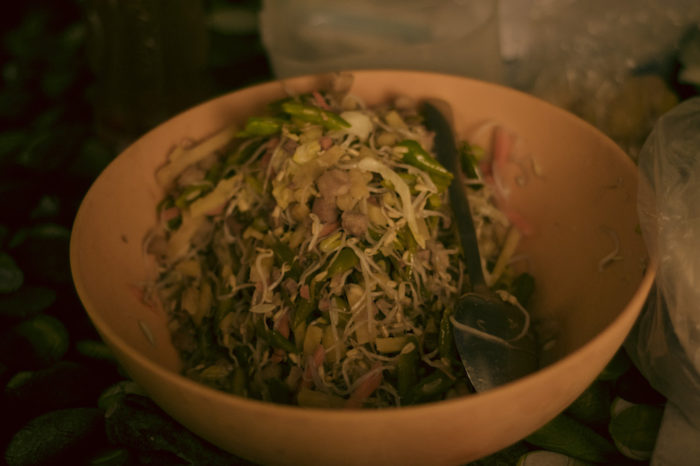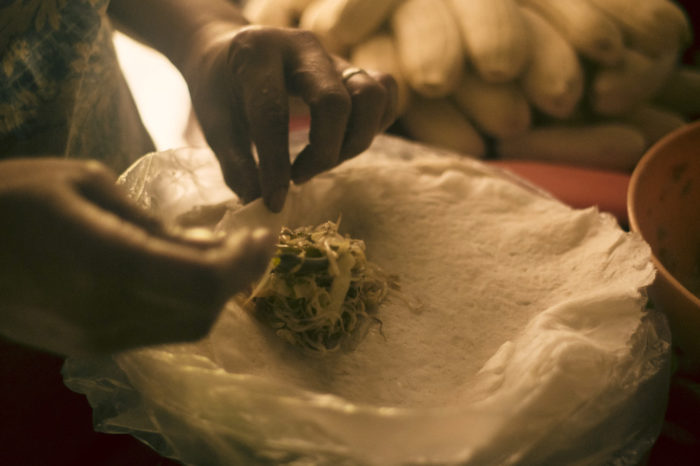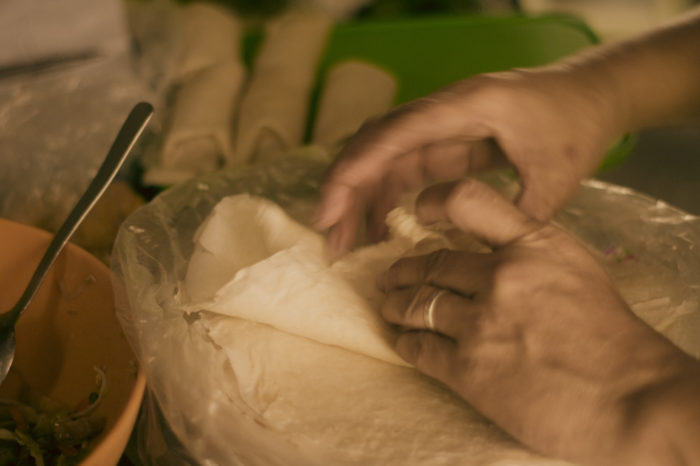
An old woman grunted that she could barely manage to stand up: she said the ginataang tilapia, whole tilapia draped in mustard leaves and simmered in coconut milk, was just too good (and too much?) for her. It’s a compliment she wanted the clientele – an interesting mix of students, bank tellers, construction workers, traffic enforcers, grocery baggers from the nearby mall, the occasional bus inspector – to hear. She gave another unsolicited remark aimed – it turned out – at me: “You know… I’ve been telling her to get a loan from a bank so she can start her own food business.” Her skill in cooking, the old woman said in Filipino, is put to waste!
The ‘her’ the old woman was talking about is Jennifer, the cook behind a nameless, makeshift carinderia in Los Baños, Laguna straddling the space between a crumbling mall and a bank. Ever since I found her spot while waiting for a Manila-bound bus some ten years ago, she’s been wearing the same dress apron, with pockets so deep it extends down to her knees, her idle hand going elbow-deep when fishing for some change.
Before her is the mise-en-place for lumpiang gulay (or what foreigners could conveniently refer to as Filipino fried spring rolls): a bowl of assorted vegetables – mungbean sprouts, sticks of carrots and sweet potatoes – and a stack of paper-thin lumpia wrappers. (Shrimp, though popular, triggered an allergy from one her customers.) She stir-fries the vegetable stuffing first: pre-cooking these ensure they’re thoroughly cooked after a quick deep-fry.
She starts making each roll by putting a spoonful of vegetables at the center of each wrapper, then with deft hands rolls and tucks the stuffing inside, folds the edges, and stacks each on a heap of rolls – neat, plump, and ready for frying. To uninitiated hands, the slightest squeeze can tear the delicate wrapper, but Jennifer does this all in swift but tender motion, her hands palpating each spring roll: every pat, wrap and tuck a hypnotic rhythm putting each roll to a quick nap.
In one of those woks blackened by age and repetitive use, Jennifer tosses each roll for a scorchingly hot bath in cooking oil.
She also uses two wrappers for each roll. It’s her foolproof way of making the rolls sturdy, so they won’t burst when fried, splattering oil in its wake. (Having taken home her lumpia in recent years, I also think this technique gives her lumpia the quality I like: it stays crisp for two or three hours longer than the average lumpia.)
The two-wrapper rule also applies to her turon: sweet spring rolls stuffed with banana and – in some versions that remain contentious to most Filipinos – jackfruit. Her version doesn’t have jackfruit; curiously, she shaves panotsa (jaggery) and drizzles them in the same wok where the turon rolls are fried, melting and coating each in the process. The result are rolls of turon with its skin glazed and dripped à la Jackson Pollock, a fragile shell of ropes and nubs of caramelized sugar.

Beyond her worktables is an open garden that doubles as a tambayan, a place where her kids stay after school, hours before they close shop. Alugbati hangs overhead, supported by trellises her family made from found branches. There are also pots of blue peas given to her by one of her suki, a frequent customer. “You pick the petals, and pour hot water on them to make tea.” The greenery is a refreshing sight.

Her operational hours is from nine to five, or “only when the sun is up,” depending on the weather. In the past 15 years of her carinderia’s existence she hasn’t had an issue with the nearby mall’s management – which legally owns her space – as her stall provides affordable meals for their employees, a food concessionaire of sorts. Asked if she’s thinking of moving to another space, a bigger stall, or that loan the old woman has mentioned earlier, she said she’s contented with how things are.
This carinderia is now closed.
We did the interview last January 2019, and by late February the store shuttered, and by March the space it occupied was vacant, as if a store had never been there. I didn’t know anyone nearby to ask about Jennifer. Meanwhile, the crumbling mall nearby is undergoing a facelift aimed to woo the town back.



2 Comments
Did you ever find out what happened? And if she moved somewhere else?
Hi Rezel, unfortunately no, I wasn’t able to look for her or trace her whereabouts…